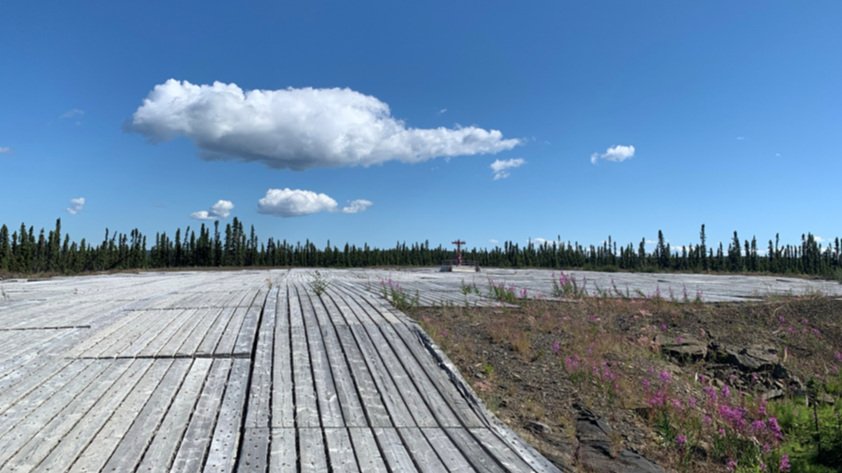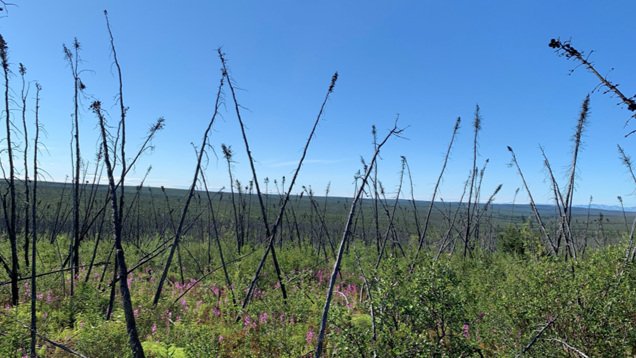An Introduction to Cumulative Effects
Many of the Yukon’s landscapes are dominated by large tracts of boreal forest, where trees, lichens, and low shrubs dominate as far as the eye can see. Even with the harsh climatic conditions of a Yukon winter, these forests continue to grow and regenerate, providing habitat for many of the Yukon’s valued wildlife species, including woodland caribou.
In the face of a disturbance, say wildfire, the forests will generally be ok – they’re resilient and the same plant species will eventually grow back, and the caribou and other animals will return to browse.
But what happens if there is a road cut through the forest to access a new mine, and then the forest burns? Or what about a new housing development right next to a wetland that has already flooded many times in recent years? How about a cut line from industrial activity followed by a new drill pad close by? All of these activities (and countless other examples) will test the resilience of the landscape.
When multiple activities make changes to the landscape at once or in quick succession, the outcomes of these activities can be compounding and can cause long-term, significant consequences to Yukon’s ecosystems.
What are cumulative effects frameworks?
Cumulative effect assessments constitute a specific form of environmental impact assessments. They are defined as comprehensive evaluations of the combined effects of human activities and natural processes on the environment. Cumulative effects frameworks:
Aim to understand how multiple pressures (including human development and activities, climate change, and natural disturbance) interact and influence natural systems
Guide how available data are used to contribute to an understanding of cumulative effects
Continuously monitor indicators and identify ecological thresholds
Approach development assessment from a regional or project-based perspective, requiring increased coordination, resources, and capacity
Data collection, analysis, and management is a coordinated effort across different governments, academic institutions, and non-governmental organizations.
The Canadian Environmental Assessment Act outlines the general steps for performing cumulative effects assessments:
The general components required in all cumulative effects assessments. Note that this does not include political or regulatory considerations.
For example, a cumulative effects assessment on potential development of McIntyre Creek/Chasàn Chùa may address some of these questions (among many others):
Components of a cumulative effects assessment applied to McIntyre Creek/Chasàn Chùa. The City of Whitehorse is exploring several development options that would cut into the McIntyre Creek corridor.
“Integrating cumulative effects into future development assessments is crucial to ensure the future environmental and social integrity of the Yukon’s landscapes.”
Current state of cumulative effects in Yukon
There is currently no cumulative effects framework established for the Yukon. This means we don’t know exactly how past, current, and future land use will influence the Yukon’s biodiversity and environmental and socioeconomic values.
As industrial activities continue, acting as if the Yukon’s resources and landscapes are limitless cannot continue. Integrating cumulative effects into future development assessments is crucial to ensure the future environmental and social integrity of the Yukon’s landscapes.
Yukon Environmental and Socio-economic Assessment Act Board (YESAB), which controls and administers the Yukon assessment process, considers cumulative effects as a contextual factor for certain project assessments. Since there is no framework to provide consistency and the data collected is not for the specific purpose of understanding cumulative effects, YESAB’s current integration of cumulative effects falls short of providing a full picture of interacting disturbances.
What do we do next?
The Northwest Territories’ Cumulative Impact Monitoring Program (CIMP) can offer operational guidance for a cumulative effects framework for the Yukon, specifically how to structure a framework that equally considers non-Indigenous and Indigenous Knowledge, functions under co-management with Indigenous governments, and coordinates different policies and levels of government.
In Yukon, land-use planning has currently been completed or started in three regions and cumulative effects are considered within each plan. The most recent plan, the Recommended Dawson Regional Land Use Pan, involves a sizeable cumulative effects section, which represents the greatest step forward in implementing the cumulative effects framework in the Yukon to date.
Specifically, this plan includes values that have not been included in previous LUPs (salmon, wetlands, stewardship, and socio-economics). Developing indicators for these values will be complex but means that the Commission recognizes that impacts can extend beyond physical land-use changes. We suggest that the standards laid out within this plan are considered the minimum standard for future cumulative effects frameworks.
This article was based off of a longer report written in collaboration with Emily Crist, intern at Yukon Conservation Society during Summer 2022.
Links for further reading:
Jones, F. C. (2016). Cumulative effects assessment: theoretical underpinnings and big problems. Environmental Reviews, 24(2), 187–204. https://doi.org/10.1139/er-2015-0073






